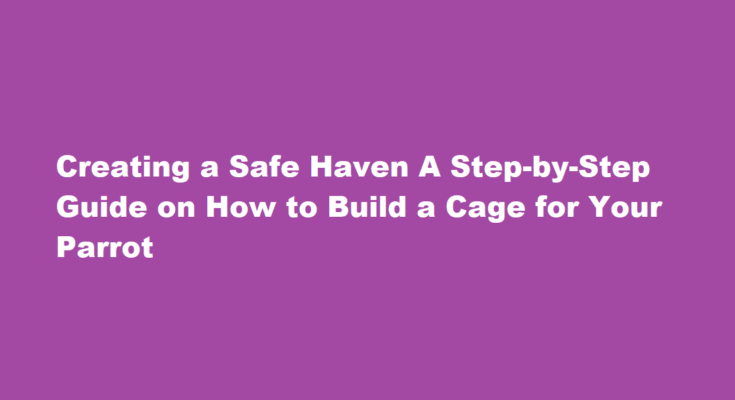Introduction
Parrots, with their vibrant plumage and charismatic personalities, make delightful companions for bird enthusiasts. However, ensuring their safety and well-being is paramount. One way to provide your feathered friend with a secure and comfortable environment is by building a cage tailored to their needs. In this guide, we will walk you through the process of constructing a parrot cage that prioritizes your bird’s health and happiness.
Understanding Parrot Needs
Before embarking on the cage-building journey, it’s crucial to understand your parrot’s specific requirements. Different parrot species have distinct needs, such as size, perch type, and bar spacing. Research your parrot’s species to ensure the cage you build is a perfect fit.
Gathering Materials
To start, collect the necessary materials for constructing the cage. You’ll need
- Welded wire mesh or metal bars (non-toxic)
- Metal cutters
- Measuring tape
- Drill
- Screws and nuts
- Plywood or solid metal for the base
- Door hinges and latches
- Perches, swings, and toys
- Non-toxic paint or coating
Designing the Cage
Sketch a design for your parrot’s cage. Consider the following aspects
- Cage size – Ensure it’s spacious enough for your parrot to stretch its wings and move freely.
- Bar spacing – Ensure the spacing is appropriate to prevent your parrot from escaping or injuring itself.
- Perches and toys – Plan the layout to accommodate perches and various toys to keep your parrot mentally and physically stimulated.
- Accessibility – Design a secure door with latches for easy access to your parrot.
Building the Frame
Cut the metal bars or welded wire mesh according to your design. Assemble the frame by connecting the bars or mesh using nuts and screws. Make sure the frame is stable and sturdy.
Creating the Base
For the cage’s base, you can choose between plywood or a solid metal sheet. Plywood is lightweight and easy to work with, while metal provides durability and ease of cleaning. Attach the base securely to the frame.
Adding Perches and Toys
Parrots need various perches to exercise their feet and prevent soreness. Include natural wood perches of different diameters to promote foot health. Additionally, hang swings, bells, and toys to keep your parrot engaged and mentally stimulated.
Constructing the Roof
A secure roof is essential to prevent your parrot from escaping. Build a sturdy roof using the same materials as the frame. Ensure it is well-ventilated and includes a latch for easy access.
Installing the Door
Create a large door for easy cleaning and interaction with your parrot. Attach hinges and a latching mechanism to ensure the door remains securely closed. Make sure there are no sharp edges or gaps that could harm your bird.
Safety First
Prioritize safety by covering sharp edges with rubber or plastic guards to prevent injuries. Ensure there are no toxic materials or substances within your parrot’s reach.
Painting or Coating
If using metal, consider applying a non-toxic paint or coating that is safe for birds. Allow it to dry thoroughly before introducing your parrot to its new home.
Placement of the Cage
Select a suitable location for your parrot’s cage. It should be away from drafts, direct sunlight, and sources of extreme temperature fluctuations. Providing a quiet and social area will help your parrot feel more comfortable.
Maintenance and Cleaning
Regularly clean the cage by removing waste, replacing bedding, and disinfecting surfaces. Ensure that food and water dishes are kept clean and filled with fresh supplies daily.
Frequently Asked Questions
What are some important factors to remember when selecting a cage?
Taller birds need cages high enough to provide plenty of tail clearance. Birds with relatively wide wingspans need a cage that will allow them to stretch out. Smaller birds such as finches require space to spread out; a larger cage will provide them with enough room for limited flights.
What should bird cages be constructed from?
The cage should be constructed from material that is strong enough to withstand the power of the bird’s beak; is easy to clean; and is non-toxic if ingested. Plastic-coated wire is commonly used for small bird cages while powder-coated bars, or even stainless steel, are used for larger cages.
Conclusion
Building a custom cage for your parrot is a rewarding project that ensures the safety and well-being of your beloved feathered companion. By understanding your parrot’s specific needs, gathering the right materials, and following a carefully planned design, you can create a secure and comfortable environment that your parrot will thrive in. Remember to prioritize safety, provide enrichment, and maintain the cage diligently to ensure a long and happy life for your avian friend.
Read Also : Building a Cozy Retreat A Step-by-Step Guide to Crafting a Dog House for Your Beloved Puppy



